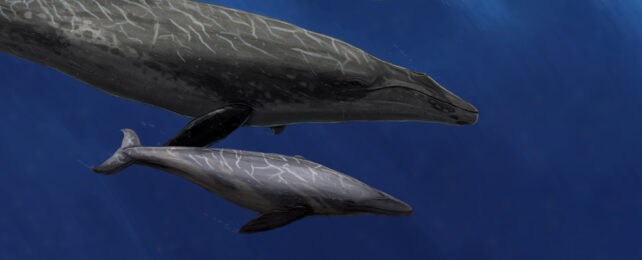How whales got huge has long fascinated researchers, but a gap in their fossil record has left precious little evidence to settle on a definitive answer.
Now a toothless whale fossil has been dated to around 19 million years old – a staggering 16 million years earlier than we realized these animals even existed.
The remains, designated NMV P218462, belonged to a warm blooded creature up to 9 meters in length – about the same size as modern minke whales. The range for the age of the fossil is anywhere between 21.12 to 16.9 million years old.
Toothless baleen whales (mysticetes) are the group of mammals that eventually produced the largest animal ever known to grace our world: blue whales, which reach up to 29.9 meters (98 feet).
Previous research suggests the mysterious lack of small whales in the fossil records from around 4 million years ago may hold a clue to the current size of many larger species.
The disappearance of less bulky beasts was attributed to an ice age which may have forced whales to migrate. Over time, bigger whales bigger were more successful at surviving such journeys, favoring a size increase.
However, this was all based only on Northern Hemisphere fossils. The new analysis by James Rule, a paleontologist from Museum Victoria in Australia, and colleagues makes the theory's timeline problematic.
The fossil was unearthed from a bank of the Murray river in South Australia in 1921. Along with other southern specimens from Peru, NMV P218462 suggests the Southern Hemisphere whales took a different journal to gigantism.
"Rather than abruptly increasing in size during the Plio-Pleistocene, southern species achieved relatively large sizes early on, perhaps as a result of greater regional productivity," Rule and team explain in their paper.
Their analysis of baleen whale body size through time shows Southern Hemisphere whales were consistently larger than those in the Northern Hemisphere.
Modern baleen whales rely on the high seasonal productivity of the Antarctic Circumpolar Current (ACC).
"It is thus perhaps no coincidence that both toothed and edentulous baleen whales first evolved larger sizes in the south, with the earliest large-bodied species coinciding with the establishment of a proto-ACC, Antarctic glaciation and seasonally productive polar ecosystems around 36–33 million years ago," the researchers write.
A major part of modern whale's diet, krill also emerged before the start of the Neogene period around 23.03 million years ago, which may have allowed them to further increase in size. Whale poop tsunamis then fertilized more plankton which fed more krill to feed more whales, engineering a self-sustaining whale carbon pump.
"Mysticetes may have catalyzed 10–20 percent of Southern Ocean net primary productivity prior to whaling," Rule and colleagues note.
"Medium-large mysticetes may have helped to engineer ocean ecosystems, albeit in a comparatively limited fashion, since the beginning of the Neogene."
This research was published in the Proceedings of the Royal Society B: Biological Sciences.
